Recruitment strategies are evolving faster than ever, leaving behind the days when social media felt revolutionary (oh my, how time flies).
Today, social recruiting is just one piece of the puzzle in a much larger, more dynamic toolkit. To stay ahead, businesses need to think beyond the familiar and tap into innovative approaches to attract and secure top talent.
This article takes a forward-looking approach, guiding you through what makes a recruitment strategy impactful, showcasing standout examples, and revealing 13 cutting-edge strategies designed to help your business thrive in 2025.
TL;DR — Key Takeaways
- A recruitment strategy is a plan of action outlining how the company will acquire talent, including what methods and tools you can use to achieve a pre-determined goal.
- A fully-formed recruitment strategy is based on a specific goal. For example, if your goal is to improve diversity and inclusion, you’ll detail which recruitment methods and tools meet this goal, such as skills-based hiring.
- There are many recruitment strategies out there, but some of the most effective examples include building a strong employer brand and talent pool, optimizing your sourcing strategies and social recruiting, and putting diversity first.
- With Toggl Hire’s expertise in employee skills testing, you can optimize your recruitment efforts and unlock the full potential of these innovative recruitment strategies.
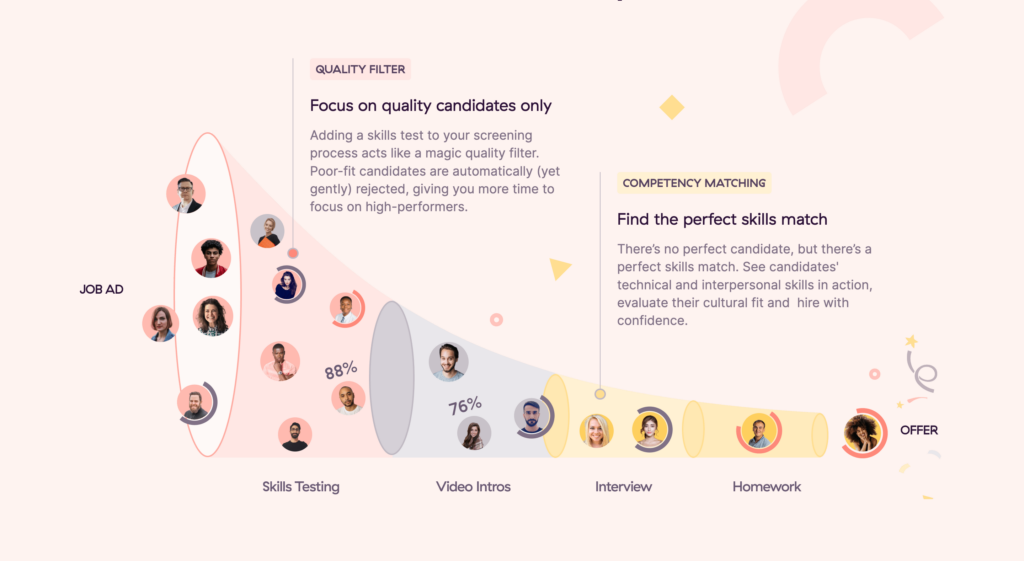
What is a recruitment strategy?
A recruitment strategy is a well-defined hiring plan that outlines the approach an organization chooses to attract, evaluate, and hire people to fill their open positions. Your strategy will include actions you’ll take at any step of the hiring process. For example, you could develop a recruiting strategy to boost candidate applications or create one to improve employee retention.
To choose the best recruiting strategy, a company should first identify its strengths and weaknesses — aka the parts of the recruitment funnel that are working well vs. those requiring improvement — and understand how the hiring process fits into these big-picture goals.

A good example of a recruitment strategy
An effective recruitment strategy should include all the tools, tactics, and goals required to bring in the best talent to drive business growth.
Let’s look at a practical example, like campus hiring. An organization with a clear growth plan and a specific profile of an employee for hard-to-fill roles might choose to create a recruiting strategy based on acquiring talent early in their career. Why? Well, it’s a relatively easy market to target!
Alternatively, a leading tech company looking to nurture diversity and foster greater innovation could adopt a “Hackathon Hiring” approach. By hosting coding competitions open to a global audience, the company could identify exceptional talent from various backgrounds while showcasing the company’s commitment to diversity and innovation.
Acquiring the right talent is the most important key to growth. Hiring was — and still is — the most important thing we do.
Marc Benioff, Chairman, Founder and CEO of Salesforce
3 things to consider before developing a hiring strategy
To reiterate, a good recruiting strategy includes all the necessary details on how you plan to achieve a set goal. So, before you can start developing any kind of strategy, it’s important to keep these three things in mind.
#1. Recruitment goals
This can be a short-term objective, like onboarding 10 new hires before the end of the year, or a longer-term goal, like improving your employer branding across the US market.
Just remember that goals should be specific, measurable, and aligned with the company’s long-term vision. And with the goals set, you’ll want to agree on the right recruitment metrics to monitor the progress.
#2. Recruiting process
When considering the specific steps you’ll take in your recruiting process, from job posting to onboarding, it’s essential to keep your recruitment goals in mind.
For example, if the goal is to onboard quickly, you’ll need a recruitment process that’s fast and efficient. Or, if the goal is to increase diversity, you’ll need to focus on inclusive best practices to achieve this goal, right down to the language used in your job ads.
For instance, at Toggl, we aim to find the best candidates while maintaining a great candidate experience. This is what our recruitment process for most of our products or roles looks like:
- A 15-minute skills test to evaluate candidates‘ core skills quickly
- When we hire for customer-facing roles, we use video intros for additional screening
- A short homework assignment to identify the most qualified candidates
- An interview with the hiring manager to confirm cultural alignment
- A paid test week to get proof of competence and conduct peer interviews

We track metrics like best candidate sources, percentage of candidates over the test threshold, applicant satisfaction scores, drop-off rates, and speed to hire to identify areas of improvement in our recruiting process.
#3. Recruitment tools
Recruitment tools like Applicant Tracking Systems (ATS), skills assessments, and automation software have become an essential part of the recruiting process because they help to:
- Streamline the hiring process
- Save hiring teams significant time and money
- Improve the candidate experience
- Reduce the risk of mis-hires
But to know which tool is right for you, you’ll need to refer back to your chosen recruitment goals and interview process to help you decide. For example, skills testing is an excellent tool to speed up candidate screening but would need to be combined with an efficient selection process if the goal is to hire more efficiently.
13 best recruitment strategies to find qualified candidates
Now we understand what recruiting strategies are and the main things to consider when developing one, let’s dive into our pick of the best recruiting strategies and tactics, and why they work in 2025.
1. Work on your employer brand
Employer branding plays a major role in attracting, hiring, and retaining great talent. In fact, 81% of organizations have taken action to improve their employer brand in the last 12 months, signaling its impact on hiring success and employee satisfaction.
Your employer brand is what makes people want to work with you and for you. Think about companies like Apple, Patagonia, Nike, and Netflix. Each has a clear mission, identity, and tone of voice that helps them stand out as industry leaders — as well as a compelling employee value proposition.
Granted, they’ve been around for a while now. But even newer companies stand to gain from strategic employer branding.
Take Revolut, for example. The global finance app went from series A funding to raising a whopping $800M in series E in the space of just five years. To reflect their incredible journey and mission, they created a unique campaign under “never settle” to attract potential candidates to their brand.
How can you implement this recruitment strategy?
Start by identifying which areas of your employer brand need work. Everything from your job ads to writing creative job descriptions to the perceived company culture falls under your employer brand — so you’ll need to investigate thoroughly to decide what needs work.
You’ll also need to engage with other departments, such as marketing and communications, to build a brand candidates want to work for.
Key employer branding elements to focus on include:
- EVP: The promise you make to potential candidates in return for their commitment to your company. Promises like “Create a world where anyone can belong anywhere” from AirBnB help to crystalize your brand’s value proposition.
- Careers page: A major opportunity to showcase your employer brand with videos, testimonials, and information on the hiring process.
- Recruitment marketing materials: Refers to all the touchpoints and ways in which you market your company to candidates long before they’re even ready to fill out an application.
- Employee ambassadorship: Another powerful tool when marketing your company brand, as brand ambassadors are perceived as more credible than corporate marketing messages.
- Job postings/ads: Actually your last chance to convince prospective candidates to apply.
Create a desirable employer brand, and we promise you that attracting great candidates becomes a whole lot easier!
Check out our guide to employer branding to create the foundation for your other recruitment strategies to build from. And learn more about the difference between employer branding and EVP to get this recruitment strategy right.
2. Polish your ideal candidate profiles
Creating an ideal candidate profile for every role is far from a waste of time. Just as marketers develop customer personas to target their efforts, a candidate profile can become an invaluable hiring tool used to:
- Create better job descriptions
- Improve sourcing strategies
- Lead to a better quality of hire
How can you implement this recruitment strategy?
Don’t let your ICPs gather dust! For them to work, you need to continually review and refresh them for every new role by following these seven steps.
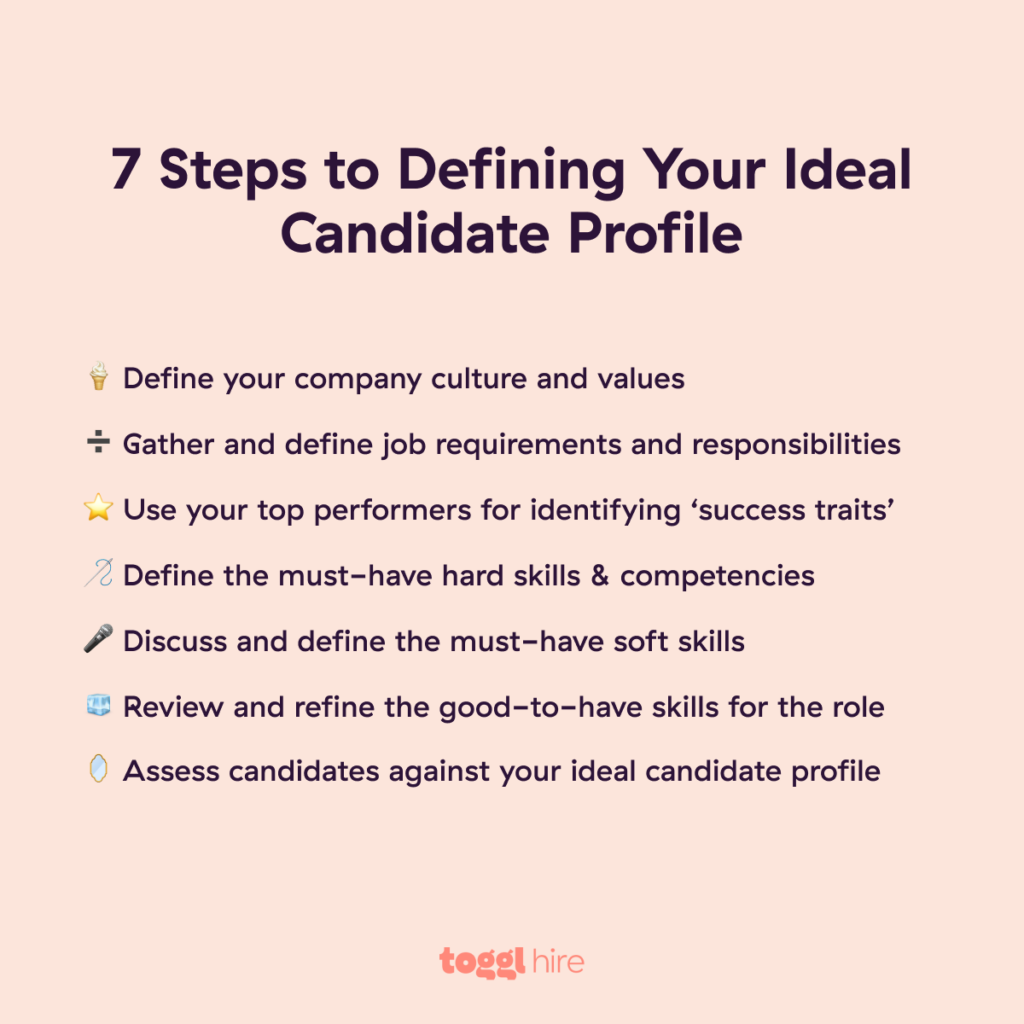
Conduct a thorough job task analysis for every new role to gather the data you need to create accurate job descriptions, as well as helping to identify skills gaps and benchmark performance standards.
3. Optimize your candidate sourcing process
Sourcing is the first stage of your talent acquisition process and refers to all your combined efforts to find and attract potential applicants to your company and/or a specific role. That includes how you target both active and passive applicants.
Given that 85% of the workforce doesn’t even scan job boards, optimizing this stage of the recruitment process can bring big rewards.
How can you implement this recruitment strategy?
Start by conducting a review of your sourcing methods and cross-check your current strategy with other creative candidate sourcing ideas. For example:
- Use external recruiters or headhunters
- Try new channels for job postings and advertising
- Open up your vacancy to remote hires
- Subcontract employees for a temporary project or position, like a maternity cover
- Incentivize more employee referrals
- Tap into your database of past applications
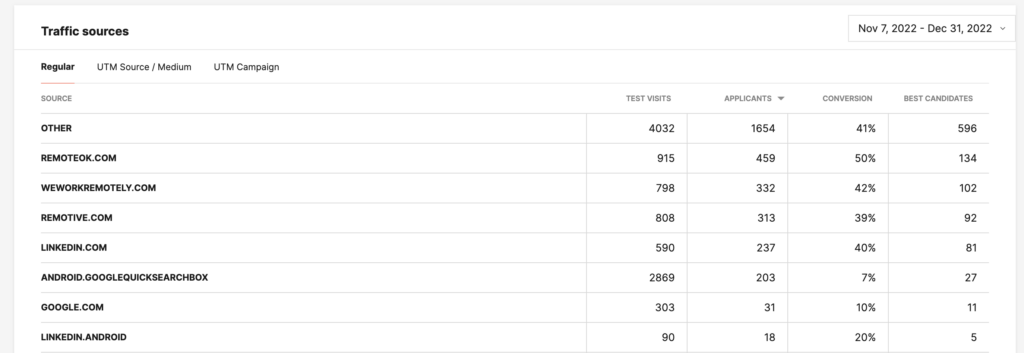
Read our recruiting metrics guide to understand what sourcing metrics you should be tracking. Plus, there’s a free template in there to help you get started straight away!
4. Attract passive candidates
According to research, only 35% of employees are not interested in looking for a new job next year. 41% are actively seeking new employment, and 24% were “unsure,” indicating they’re in the passive market and could be swayed by the right opportunity if it came along.
Given that passive candidates aren’t actively looking for new roles, it’s important to realize you aren’t going to engage with them on job boards. Instead, you need to adopt a long-term talent acquisition philosophy to ensure you get seen by passive talent long before they’re looking for a new role. This way, when they are eventually on the market, they’ll think of you!
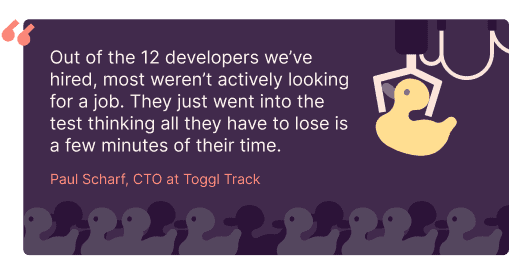
How can you implement this recruitment strategy?
There are many ways to get the attention of passive candidates, for example:
- Create a strong employer brand: As we saw before, employer branding is one of the most powerful ways to get the attention of passive candidates.
- Gamify your application process with skills tests: We’ve seen first-hand how effective skills testing can be in capturing the attention of passive talent.
- Be seen on social media: Whatever space you’re in, your company’s social media profiles can be used as tools to convert your passive followers into active candidates.
Explore our tips for attracting passive candidates and start devising your recruitment strategy. Curious about gamifying your application process? Browse our skills assessment templates to get inspired!
5. Put diversity first
Finally, what we’ve all known has been proven. Diversity and inclusion in the workplace not only helps to level the playing field for minority groups, but it also carries many real business benefits.
- Companies in the top quartile for diversity representation have a 39% greater likelihood of financial outperformance than companies in the bottom percentile.
- Diverse teams are 87% better at making decisions
- Companies that welcome diversity are 1.7x more innovative
Given those stats, and in this day and age, you really shouldn’t need any more convincing about putting diversity first.
How can you implement this recruitment strategy?
Global pharmaceutical company and top-ranking employer Novartis is a leading example of putting diversity first. Of course, being a large company with big responsibilities, its diversity initiatives have grown to the point of needing a Chief Diversity & Culture Officer.
But even long before your company’s culture gets to that level, there are still many things you can do:
- Pay close attention to job postings and descriptions to check for inclusive language
- Try blind hiring and anonymous applications
- Remove bias with skills tests and unconscious bias awareness initiatives
- Switch up the job boards you use and try including niche job boards that specialize in a particular sector, field, or skill set
Get on Google and start searching for job boards tailored to your niche. Simply search for ‘your role’ + job boards – for example ‘marketing + job boards.’ And for more diversity ideas, explore our blog on 31 DEI Tips: How to Promote Inclusivity in the Workplace.
6. Create a talent pool
One of the biggest challenges in recruitment is often sourcing suitable candidates with the skills and experience you need. One way to tackle this problem is to build a high-quality talent pool and keep a list of vetted candidates on standby.
However, a great talent pool isn’t just a list of names and phone numbers. A properly curated talent pool provides rich information on each potential candidate, including their:
- Experience
- Hard & soft skills
- Attributes
- Career goals
- Cultural fit to your organization
- Suitable roles
If you’re going to implement any long-term recruitment strategies, building a talent pool is one we’d definitely recommend. Not only will it boost your speed to hire, but it will also reduce costs and keep the best candidates engaged with your business.
How can you implement this recruitment strategy?
The first step is to acknowledge all the different methods that can contribute to your talent pool.
For example:
- Candidate sourcing campaigns
- Leads from career events
- Software like Toggl Hire keeps track of all applicants (including unsuccessful applicants that may be suited to a different or future role)
- Community
- Passive candidates
- Candidate profiles on platforms like LinkedIn, Github, and UpWork
The second step is to start exploring different strategies and best practices for creating and maintaining a robust talent pool.
For example:
- Sorting and segmentation: To extract the most value from your existing talent pool and remain organized when growing it, you’ll need to segment by attributes like job function, skills, experience level, location, and interests.
- Nurturing and engagement: It’s not enough to simply collect and sort candidate details; you need to stay connected with candidates in your talent pool through things like social media, events, and outreach.
- Personalization: Your segmentation will prove invaluable when recruiting from your talent pool, but it’s also essential to personalize your communications to build and maintain that relationship.

Do some research on how to build a great talent pool here. Then start putting the techniques into action, starting with your recruiting team reaching out to previous candidates.
7. Develop an employee referral program
Employee referral programs aren’t new, but getting them right is still tricky. Asking your current employees to refer great people from their network is an effective way to connect with outstanding talent. And what makes this recruitment strategy so sought-after is that it’s free.
Employee referrals are one of the best recruitment strategies because:
- Referred candidates have lower turnover rates
- They’re better quality hires
- They help reduce your time to hire
- They’re cost-effective for sourcing
How can you implement this recruitment strategy?
The trick with employee referral programs is to strike a balance between incentivization and quality. You want your staff to actively refer people from their network but not their low-quality connections.
But the good news is that building employee referral programs is quick, low-cost, and delivers qualified candidates fast! No wonder it’s one of the favorite recruitment strategies among technical recruiters.
8. Nail your social media recruiting efforts
The rise of digital technology and social media has fundamentally changed the way candidates and recruiters interact. Digital hiring strategies and social media help recruiters find, engage with, and acquire the best talent on the market.
Here are some stats to back this up:
- 79% of job seekers have used social media in their job search in the last year.
- On LinkedIn alone, 9,000 candidates apply, and 7 candidates are hired every minute.
- Candidate application rates increase 34% when the job postings include a video. LinkedIn also reveals that video views are up 36% year on year.
The fully remote workflow automation company Zapier is a great example of social recruiting in practice. The company uses innovative ways to engage and connect with its target audiences and prospective job candidates.
For example, during the summer, the company posted the results from its first “no-meeting week,” during which 80% of the team achieved their goals and gave others a meaningful look into the company culture.
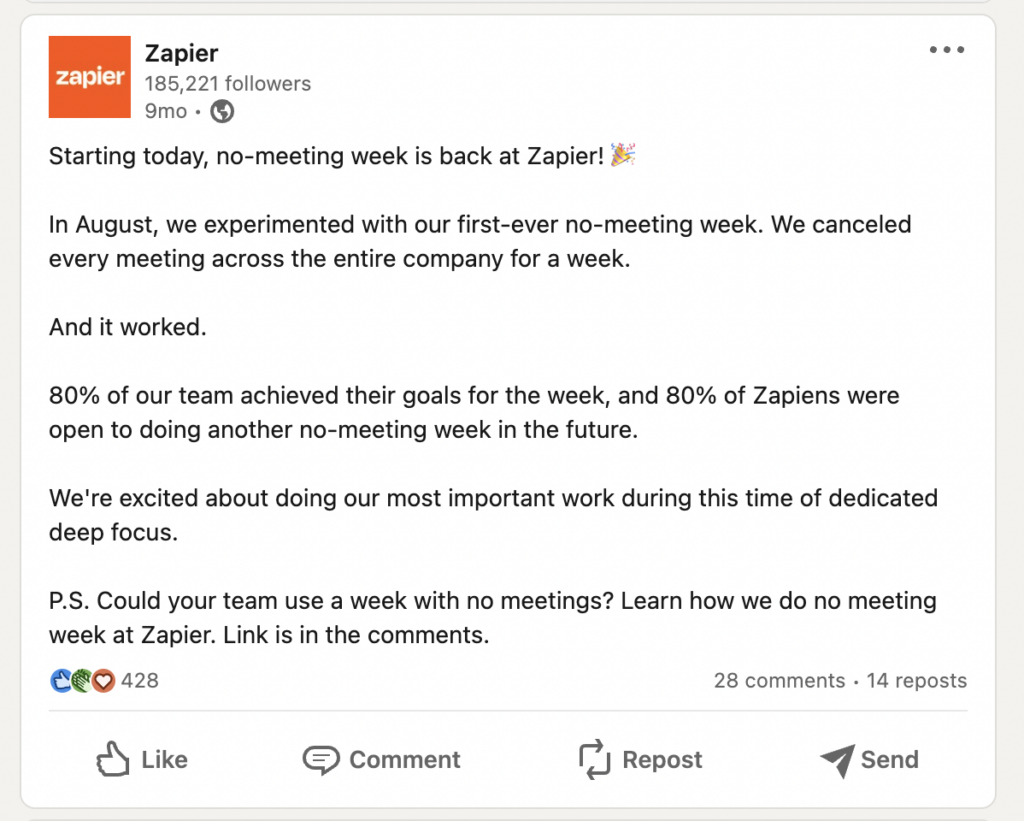
How can you implement this recruitment strategy?
To get started with social recruiting, consider the following:
- Choose the social media platforms most relevant to your audience and recruitment goals
- Post frequently sharing news and insights into job openings, job fairs, networking events, company milestones, product updates, contests, what it’s like to work at your company, etc
- Engage with followers and potential candidates by responding to their questions and comments
- Encourage employee referrals and engagement by current employees
- Measure and track how your social recruiting efforts perform in order to adjust and optimize your social recruiting strategy
Kickstart your social media recruiting strategy with our eleven examples, from crafting easy-to-read job descriptions and sharing a mix of content types to measuring your success.
9. Connect with graduates
Graduates are the future, literally. For many roles, graduates are just a graduation away from clicking apply. In fact, many graduates are encouraged to secure their places up to a year before they even finish their courses, and this represents a candidate pool that shouldn’t be ignored.
Here are just some of the reasons why you should consider creating a recruiting strategy targeting graduates:
- They cost less as graduates start their careers
- They’re motivated to keep learning, with 94% of graduates surveyed citing work as an avenue for building their skills
- They have excellent knowledge of the latest digital tech and software to help your business thrive
- They bring fresh perspectives from their learning experience
How can you implement this recruitment strategy?
4 ways you can connect with graduates include:
- Social media: Using creative, bespoke recruiting campaigns to target university students, like this creative ad campaign from Amey below.
- Job fairs and careers days: Attending multiple events for employers hosted at universities
- Your benefits package: Another way to hook graduates is by making a better offer than your competitors and including perks like gym memberships or flexible hours that make all the difference
- Candidate experience: Recruiting in this space is highly competitive, and another way to differentiate your brand is through the candidate experience.
Find out how Telia used skills assessments at a student campus event to source talented candidates and build a qualified talent pool.
10. Attend or host industry events
In an increasingly remote world, there is a lot of value in attending in-person events. Company and industry events can raise your profile within your industry, bring value to your network, and position your business as an exciting and innovative place to work.
From a recruitment perspective, events are a great way to synergize with several other recruitment strategies. They raise your employer brand, plant the seed with passive candidates, and are an opportunity to build a talent pool.
How can you implement this recruitment strategy?
Start with Hootsuite’s awesome guide on how to host your own virtual events. These ideas offer a quick, easy, and low-cost way to start boosting your business profile and meet future candidates.
If you’re in tech, this could be a hackathon. For the arts industry, try hosting an exhibition. Or, if you’re in marketing, go to a conference.
That’s not to say you shouldn’t hold remote events. Something as simple as hosting a webinar on an industry hot topic or a virtual job fair is still a powerful way to bring people together.
When attending industry events, like the epic Web Summit for techies, look into sponsorship opportunities to further spotlight your brand!
11. Create an internship program
Last but not least, one of the most effective recruitment strategies that has never fallen out of fashion in the world of talent acquisition is the implementation of internship programs. Statistics show that candidates who complete internships are 85% more likely to secure a full-time job after graduation.
These programs offer hiring managers a unique opportunity to identify and nurture promising talent within their organizations by allowing both employers and candidates to assess their compatibility before making long-term commitments.
This strategy works exceptionally well because it provides an extended evaluation period and serves as an effective talent pipeline.
How can you implement this recruitment strategy?
For a successful internship program, start by doing research to:
- Identify which departments or teams should have an internship program
- Define the objectives and goals of the program for the team, individuals, and wider organization, as well as the terms and compensation they will receive to attract interns to your program
- Promote your internships through various channels, such as career fairs and universities, as well as your careers page and social media.
- Refine your program by gathering and incorporating feedback
- Measure and assess the success of your program by tracking key metrics such as intern satisfaction, the number of interns who were offered full-time roles, and subsequent retention rates
12. Provide a safe workspace free of political discussions
Global political events such as the US election and war in the Middle East appear to be spilling over into the workplace, causing discomfort for employees. A recent Politics at Work report finds that:
- 75% of employees are considering leaving their jobs due to political discussions at work
- 60% believe political discussions should be banned at work altogether
- 66% have lied about their political views to fit in with their colleagues
- 94% of entry-level colleagues are more likely to lie about their political beliefs, compared to 44% of senior managers
Potential applicants, especially those seeking junior roles or even those who have experienced the fallout of political discussions in their previous workplace, need reassurance you’re offering a safe space free from potential conflict.
How can you implement this recruitment strategy?
Admittedly, it’s easier to publicize your anti-politics stance to an audience of existing employees rather than potential applicants. But there are steps you can take to reassure candidates of your company values, such as:
- Using your social platforms to highlight your company culture and the benefits of not discussing presidential candidates at work
- Using interviews to communicate how your commitment to a politics-free environment contributes to a harmonious workplace culture
- Highlighting your commitment to a respectful environment on your careers page, job descriptions, and recruitment marketing materials
13. Appeal to the hidden workforce
As much as 14 to 17% of the US workforce comprises hidden talent, packed with skills, but whose resumes are often overlooked in favor of more traditional candidates. These hidden workers may include:
- Neurodiverse employees
- Workers forced into retirement who would relish the opportunity to return to work
- Caregivers who have left the workforce to support their dependents
- Ex-inmates struggling to find an employer willing to give them a second chance
- Veterans who haven’t yet found a civilian role
- Menopausal employees who have been forced out of work due to their age or symptoms
- People with long-term physical or mental health problems
These candidates may never have been employed or may have been forced out of the workplace due to their situation. Whatever their individual circumstances, they have limitless skills to offer an employer.
How can you implement this recruitment strategy?
To tap into this hidden talent pool, consider implementing these steps:
- Partner with organizations that specialize in helping individuals from these groups to find employment
- Review your recruitment processes and job descriptions for language or requirements that may deter these candidates from applying
- Offer flexible working arrangements, such as part-time or remote work options
- Implement a returnship program for caregivers or retirees looking to re-enter the workforce to demonstrate your commitment to supporting employees at all stages of their careers
- Follow up with candidates who have requested recruitment accommodations to understand how you can support them throughout the hiring process
- Assert your commitment toward skills-based hiring, and how you plan to use skills assessments to find the best person for the job.
Where does Toggl Hire come in?
If you want to fill more positions, attract better-quality candidates, and decrease your time to hire, these 13 effective recruitment strategies offer some easy-to-implement ideas.
Combine every strategy we’ve covered with skills testing to give your hiring metrics an extra boost! This is great for candidates, too, as it provides a more exciting way to showcase their talents and gives them instant feedback.
Incorporating hiring tests into your recruitment strategy has many benefits
- Gamify the application experience to attract top talent and passive applicants
- Improve the quality of hire & speed to hire, as it’s easier to recognize top talent
- Reduce unconscious bias for more diverse talent
- Higher quality candidates at every stage of the pipeline
- Create a talent pool in Toggl Hire with extensive information on candidates’ skills & past applications
Remember, the ultimate key to a successful recruiting strategy is creating a slick and efficient hiring process. Try Toggl Hire’s skills testing for free today.
Rebecca has 10+ years' experience producing content for HR tech and work management companies. She has a talent for breaking down complex ideas into practical advice that helps businesses and professionals thrive in the modern workplace. Rebecca's content is featured in publications like Forbes, Business Insider, and Entrepreneur, and she also partners with companies like UKG, Deel, monday.com, and Nectar, covering all aspects of the employee lifecycle. As a member of the Josh Bersin Academy, she networks with people professionals and keeps her HR skills sharp with regular courses.















